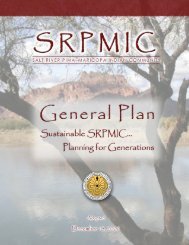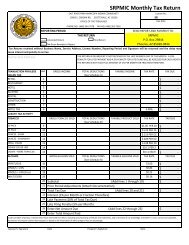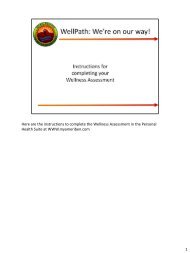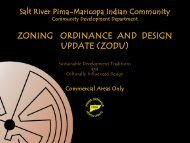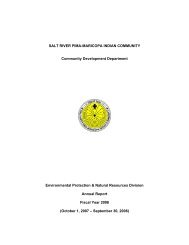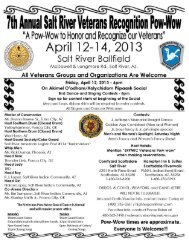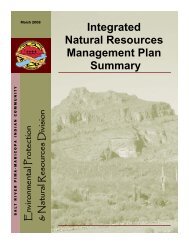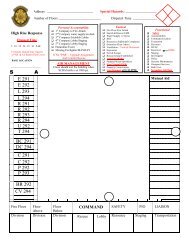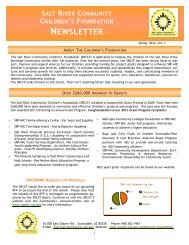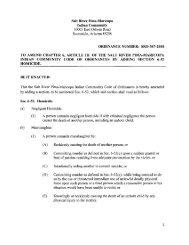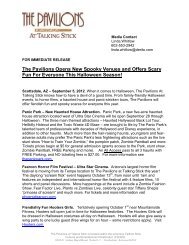2009 - Salt River Pima-Maricopa Indian Community
2009 - Salt River Pima-Maricopa Indian Community
2009 - Salt River Pima-Maricopa Indian Community
Create successful ePaper yourself
Turn your PDF publications into a flip-book with our unique Google optimized e-Paper software.
Introduction<br />
EPNR <strong>2009</strong> Staff Photo (left to right)<br />
Back Row: Raleigh Lomatska, Dan Daggett, Mark Aaron, Wang Yu, Greg Little, Brian Gewecke<br />
Middle Row: Angela Cruz, Jenifer Williams, Joe “Cricket” Herrera, Stan Belone, Tom Wright, Chris Horan, Corwin Smith,<br />
Gina Leverette, Carol Hibbard, Amy Miguel, Denise Taylor, Elaina Osife<br />
Front Row: Esther Moyah and Ondrea Barber<br />
Not Pictured: Tudor Montague<br />
Environmental Protection & Natural Resources<br />
The mission of the Environmental Protection & Natural Resources Department (EPNR) is to<br />
protect, preserve, restore, and regulate the <strong>Community</strong>’s natural resources and archaeological<br />
heritage by enforcing regulatory programs and providing educational opportunities to the<br />
<strong>Community</strong>. EPNR administers environmental regulatory programs, addresses environmental<br />
issues, and monitors growth and development to reduce the impact to the <strong>Community</strong>’s<br />
environmental and natural resources. EPNR staff perform site inspections and monitoring<br />
activities to ensure compliance with <strong>Community</strong> and Federal laws. EPNR also manages and<br />
analyzes data, writes technical reports, and performs environmental outreach and education to<br />
increase awareness about environmental issues that impact the <strong>Community</strong>.<br />
EPNR consists of five distinct programs, with varied environmental and natural resource<br />
components. These include the Air Quality Program (AQP), Land Use Compliance Program<br />
(LUC), Range Management Program (RMP), Water Quality Program (WQP), and the<br />
Environmental Policy and Program Development (EPPD). Hazardous substances, pesticides<br />
issues, solid waste, recycling, and policy development are all housed under Environmental Policy<br />
and Program Development. The major accomplishments in Fiscal Year <strong>2009</strong> (FY<strong>2009</strong>) of these<br />
five programs are relayed in the following pages.<br />
2



